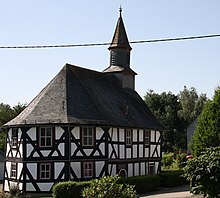Mannus Riedesel
Mannus Riedesel (born June 6, 1662 in the Melbach (today part of the municipality of Erndtebrück ); † November 4, 1726 in the Melbach; buried on November 5, 1726 in Raumland ) was a German master carpenter .
Life
Riedesel comes from a family that has lived in Melbach since 1618 (and probably earlier) (see Riedesel ).
The spelling of his first name varies. He is entered in the baptismal register on June 6, 1662 under "J" as Johann Mannus , son of Heirich Reittesel. But there are also the terms Hermann or Hermann Mannes , the most common is simply Mannus . In 1702, he himself chose the spelling Manes Rittessel for his name on a beam of his own farm in Melbach .
Riedesel was married twice and had five children.
Services
Mannus Riedesel was the most important master carpenter in the Wittgenstein region. Not only did he build houses and barns in Wittgenstein and the neighboring Siegerland, the Berleburger Count House and the Siegen Princely House also gave him important orders.
It is not known where and with whom he trained as a carpenter.
The most popular forms of jewelry from Riedesel were vine leaves and vines, for example on the corner post of the Hainhof in Puderbach. or his barn in the Melbach.
The best-known preserved buildings of Riedesel are the Stoltz'sche Haus in the Königsstraße in Laasphe (1705), the Protestant chapel in Sassenhausen (1703/05) and the Ludwigsburg in Bad Berleburg (1724).
Works
- Half-timbered storey at Hilchenbach Castle , 1691.
- His barn in Melbach , 1702.
- Sassenhausen Chapel , 1703/05.
- Rectory in Wingeshausen , around 1703/05.
- Stoltz'sches house in the Königsstrasse of Bad Laasphe , 1705.
- 1st construction phase of Ludwigsburg in Bad Berleburg , 1707–1709.
- Greenhouse (orange or orange house) in the princely garden in Siegen Castle , 1708.
- Berghäuser Bridge (House Bridge) , 1709.
- Grebe House in Bad Laasphe , Königsstrasse 64 , 1709.
- Dambach farm , 1711.
- Hain-Hof in Puderbach , 1712.
- 2nd construction phase of Ludwigsburg (Bad Berleburg) , 1724.
- House Parkstrasse 5 in Bad Berleburg , 1725.
- Fuchs's house in Wunderthausen , 1726.
literature
- Eberhard Bauer: The former rectory in Wingeshausen - a Riedesel building? In: Wittgenstein, Blätter des Wittgensteiner Heimatverein eV, Vol. 56, (1992), Issue 3, pp. 112-116.
- Wolfgang Birkelbach: The family history of the Wittgenstein carpenter Mannus Riedesel or the Riedesel in Herjes house in the Melbach. In: Wittgenstein, Blätter des Wittgensteiner Heimatverein eV, Vol. 44 (1980), Issue 4, pp. 114-123 and Vol. 45 (1981), Issue 1, pp. 18-27.
- Johannes Burkardt: The chapel in Sassenhausen: A friendly guide to the heart of the Wittgenstein region. In: Bernd Geier (Ed.) Sassenhausen, Bad Laasphe 2001, pp. 16–50.
- Johannes Burkardt: Mannus Riedesel with a completely different look - a calligraphic petition from the builder to Count Casimir zu Sayn-Wittgenstein Berleburg. In: Wittgenstein, Blätter des Wittgensteiner Heimatverein eV, Vol. 69 (2005), Issue 2, pp. 34-39.
- Wilhelm Hartnack : The Stoltz'sche house at Königsstrasse 49 in Laasphe. In: Wittgenstein, Blätter des Wittgensteiner Heimatverein eV, Vol. 21 (1957), Issue 2, pp. 95-96.
- Joachim Naumann: The school chapel in Sassenhausen and master carpenter Mannes Riedesel. In: Wittgenstein, Blätter des Wittgensteiner Heimatverein eV, Vol. 36 (1972), Issue 4, pp. 206-211.
- Joachim Naumann: The world of work and ways of life in the building trade in the Wittgenstein territorial state of the modern age (1550-1850) . Diss. Marburg / Lahn 1972 (Here in particular pages 283–287, where the life and work of Riedesel is reported.)
- Hans-Günter Radenbach: The house bridge . In: Wittgenstein, Blätter des Wittgensteiner Heimatverein eV, Vol. 49 (1985), Issue 4, pp. 122–128.
- Helmut Richter: A Wittgenstein farm. The Dambach. In: Wittgenstein, Blätter des Wittgensteiner Heimatverein eV, Vol. 30, (1966), Issue 1, pp. 61-66.
- Helmut Richter: Pictures from Wittgenstein. Drawings from four decades . Bad Berleburg 1986
- Helmut Richter: Why Hermann Riedesel? In: Erndtebrück, Vol. 1, 1977, p. 10 ff.
- Paul Riedesel and Stefan Hermann Riedesel: The Origin of the Name Riedesel in the County of Wittgenstein: New Findings on Its Origin . In: Wittgenstein, Blätter des Wittgensteiner Heimatverein eV, Vol. 71, (2007), Issue 4, pp. 140–155.
- Paul Riedesel and Stefan Hermann Riedesel: Why was Mannus Riedesel so close to the Count's House of Sayn-Wittgenstein-Berleburg? In: Wittgenstein, Blätter des Wittgensteiner Heimatverein eV, Vol. 76, (2012), Issue 1, pp. 13-15.
- Paul Riedesel and Stefan Hermann Riedesel: The origin of the name Riedesel in the county of Wittgenstein: Known and new theories . In: Wittgenstein, Blätter des Wittgensteiner Heimatverein eV, Vol. 78, (2014), Issue 2, pp. 68-83.
Web links
Individual evidence
- ^ Birkelbach, The Family History ... In: Wittgenstein 1980, p. 118
- ^ Richter, Why Hermann Riedesel? In: Erndtebrück, Vol. 1, 1977, p. 10.
- ^ Naumann, The school chapel in Sassenhausen ... In: Wittgenstein 1972, Heft 4, p. 209.
- ^ Richter, drawings from Wittgenstein . 1986, p. 194
- ^ Bauer: The former rectory in Wingeshausen - a Riedesel building ?. In: Wittgenstein . 1992, issue 3, p. 112 ff.
- ^ Radenbach, The House Bridge . In Wittgenstein 1985, No. 4, p. 122 ff.
- ^ Siegener Zeitung of November 2, 2012, Wittgenstein edition, The Hain-Hof is 300 years old, p. 5
| personal data | |
|---|---|
| SURNAME | Riedesel, Mannus |
| ALTERNATIVE NAMES | Riedesel, Johann Mannus; Riedesel, Hermann Mannes |
| BRIEF DESCRIPTION | German master carpenter |
| DATE OF BIRTH | June 6, 1662 |
| PLACE OF BIRTH | Melbach |
| DATE OF DEATH | November 4, 1726 |
| Place of death | Melbach |




